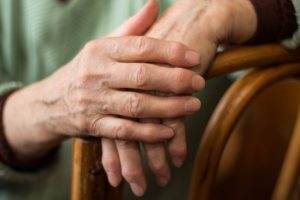Baseball places significant demands on the shoulder and elbow joints, making them susceptible to injuries from repetitive motions like throwing and swinging. As an experienced orthopedic specialist, I frequently treat athletes suffering from common baseball injuries such as rotator cuff tears, labral tears, biceps and UCL injuries. Understanding these injuries in baseball and implementing prevention strategies can help keep players healthy and performing at their best.
About the Author: Joseph Tauro, MD, a Board-Certified orthopedic surgeon by the American Board of Orthopedic Surgeons, is nationally recognized for his expertise in treating shoulder, sports, and degenerative joint disorders. As a professor at Rutgers Medical School and a Master Instructor for the Arthroscopy Association of North America (AANA), he leads the field in developing new techniques for minimally invasive joint replacement, arthroscopic shoulder surgery, and Augmented Reality surgical training. Patients from across the U.S. are referred to Dr. Tauro for his specialized care. Request an appointment with Dr. Tauro today to experience expert orthopedic care first-hand!
Common Shoulder and Elbow Injuries in Baseball
Shoulder Injuries in Baseball:
- Rotator Cuff Injuries: The rotator cuff is a group of muscles and tendons that stabilize the shoulder. Repetitive throwing can cause rotator cuff tears (typically partial tears) or inflammation.
- Labrum Tears: The labrum is a ring of cartilage that surrounds the shoulder socket. Labrum tears can occur from overuse or trauma, leading to pain and instability
- Biceps tears: These are typically partial tears or tendinitis. There’s a type of labral tear associated with biceps problems called a SLAP lesion.
- Shoulder Impingement: This occurs when the rotator cuff tendons are pinched during shoulder movements, causing pain and reduced range of motion.
Elbow Injuries in Baseball:
- Ulnar Collateral Ligament (UCL) Injury: The UCL stabilizes the elbow during throwing motions. Repetitive stress can cause UCL tears, sometimes requiring surgical repair (Tommy John surgery).
- Flexor Tendinitis: Inflammation of the tendons that attach to the inner elbow, often caused by overuse.
- Olecranon Stress Fracture: Repeated stress on the elbow can cause small fractures in the olecranon, the bony tip of the elbow.
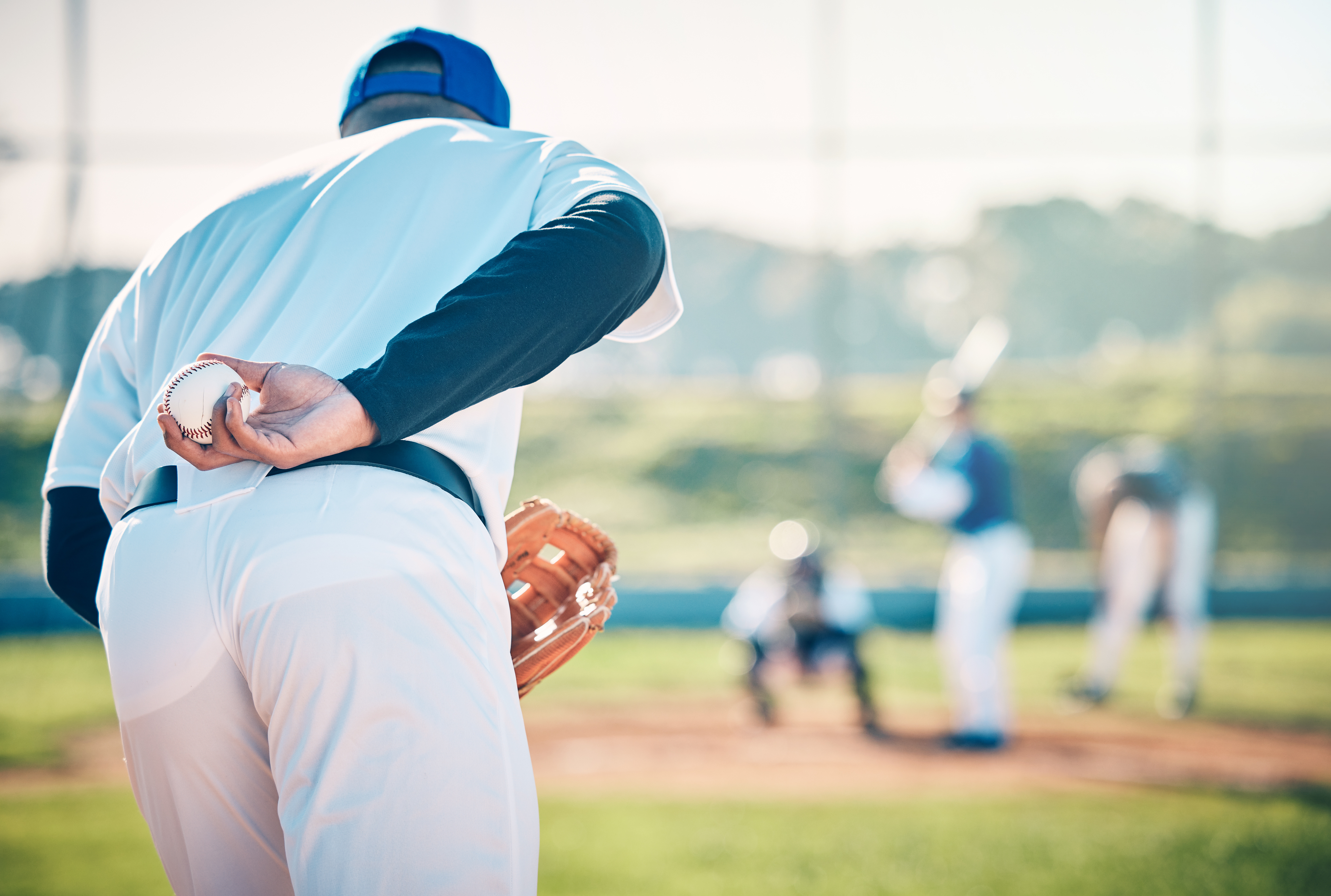
Prevention Strategies for Arm Injuries in Baseball
Proper Mechanics:
- Ensuring proper throwing mechanics can reduce stress on the shoulder and elbow. Working with a coach or physical therapist to refine technique is crucial.
Strengthening and Conditioning:
- A well-rounded conditioning program focusing on shoulder and arm strength, flexibility, and endurance can help prevent injuries. This includes exercises targeting the rotator cuff, scapular stabilizers, and core muscles.
Pitch Counts and Rest:
- Adhering to pitch count guidelines and ensuring adequate rest between pitching sessions can help prevent overuse injuries. The American Sports Medicine Institute (ASMI) provides guidelines on appropriate pitch counts for different age groups.
Warm-Up and Cool-Down:
- Proper warm-up and cool-down routines are essential. Dynamic stretching before activity and static stretching afterward can maintain flexibility and reduce injury risk.
Monitoring Symptoms:
- Players should be encouraged to report any pain or discomfort early. Early intervention can prevent minor issues from becoming major injuries.
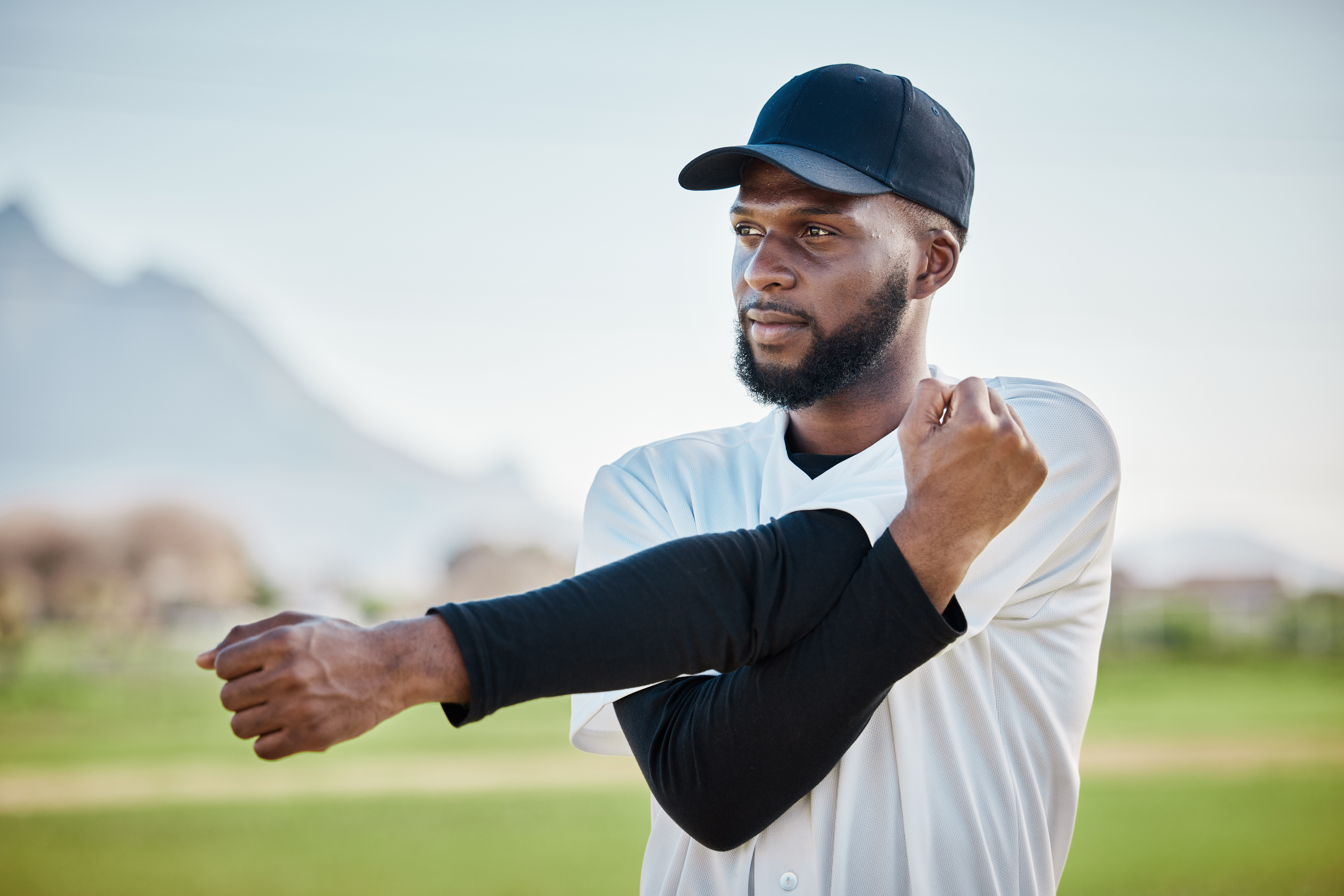
Treatment Options for Arm Injuries in Baseball
Non-Surgical Treatments:
- Rest and Ice: Initial treatment for most shoulder and elbow injuries involves rest and ice to reduce inflammation.
- Physical Therapy: A structured rehabilitation program can help restore strength and range of motion.
- Medications: Nonsteroidal anti-inflammatory drugs (NSAIDs) can help manage pain and inflammation.
Surgical Treatments:
- Arthroscopy: Minimally invasive surgery can repair labrum tears, remove impinging bone spurs, or debride damaged tissue.
- Tommy John Surgery: Reconstruction of the UCL using a tendon graft, often necessary for severe UCL injuries.
Rehabilitation:
- Post-surgery rehabilitation is crucial for a successful return to play. This includes progressive strength and flexibility exercises, often guided by a physical therapist. At AOSMI, we have a team of expert physical therapists to help you recover from your shoulder and elbow injuries.
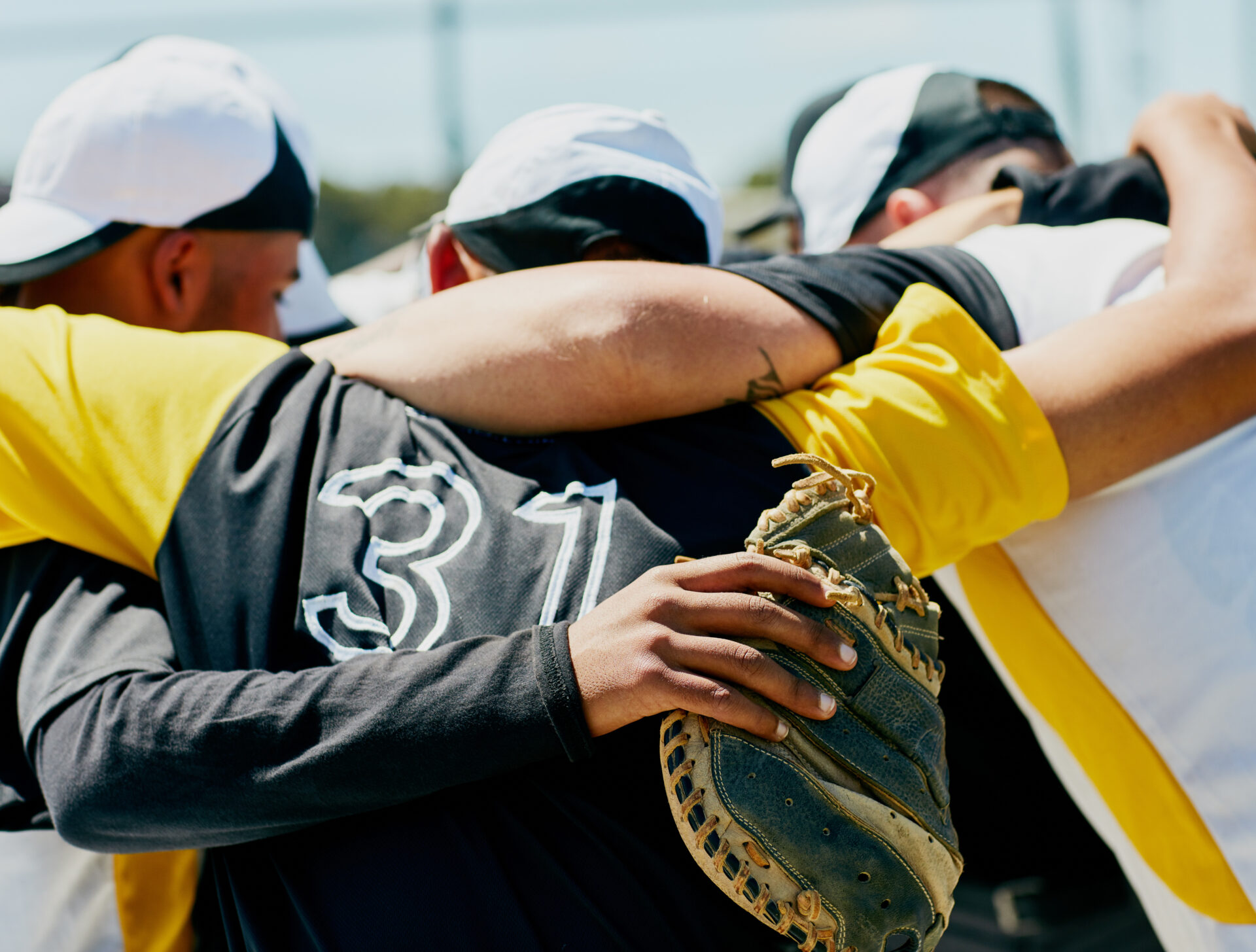
Recover from Baseball Arm Injuries with Comprehensive Orthopedic Care at AOSMI in New Jersey!
Preventing and treating shoulder and elbow injuries in baseball requires a comprehensive approach that includes proper mechanics, conditioning, adherence to pitch counts, and early intervention. Dr. Tauro and the AOSMI team specialize in diagnosing and treating sports injuries, helping athletes return to their peak performance.
If you’re experiencing shoulder or elbow pain from playing baseball, don’t wait and risk further injury. Dr. Tauro and the AOSMI team offer comprehensive evaluations and expert care tailored to your needs. Early diagnosis and treatment can significantly improve your recovery and get you back in the game faster and stronger – schedule an appointment with Dr. Tauro today to start your path to recovery!
As the excitement of the 2024 Olympic Games captivated the world, gymnastics was one of the most thrilling and physically demanding sports on display. With its combination of strength, flexibility, and precision, gymnastics places extraordinary demands on athletes, particularly young gymnasts. However, with these demands comes an increased risk of injury, especially to the shoulders and elbows. Gymnasts, particularly children, adolescents, and young adults, are at a higher risk for these types of gymnastics injuries, underscoring the importance of early detection and treatment. At AOSMI, we support and encourage young gymnasts to pursue their passion, whether competitively or recreationally. If your child experiences pain or injury from gymnastics, our team is here to provide expert care and help get them back to the sport they love.
About the Author – Stacey Gallacher, MD, FAAOS, is a Board-Certified Orthopedic Surgeon specializing in shoulder and elbow surgery, with dual Fellowship training in Shoulder & Elbow Surgery and Trauma. With specialty training in trauma, Dr. Gallacher provides trauma care for adult fractures, including reconstruction and replacement of complex shoulder and elbow fractures. She strives to provide a comprehensive approach to recovery including both non-surgical and surgical techniques to minimize pain and restore function. A former Division I collegiate athlete herself, she is passionate about helping patients maintain an active lifestyle, and enjoys cycling, surfing, and yoga in her personal time. Dr. Gallacher is also active in academic pursuits, serving as a member of the AAOS, and Assistant Editor for the Journal of Shoulder and Elbow Arthroplasty.
Gymnastic Shoulder Injuries – Labral Tears
The labrum is a ring of cartilage that stabilizes the shoulder joint. Tears can occur from repetitive overhead movements or acute trauma, leading to pain, instability, and decreased performance.
Causes:
- Common Events: Rings, uneven bars, and vaulting.
- Mechanisms: Repetitive stress from overhead movements, falls, or sudden jerks during dismounts.

Orthopedic Treatment:
- Non-surgical Management:
- Physical Therapy: Initial focus on reducing inflammation and pain. Specific exercises aim to strengthen the rotator cuff and shoulder stabilizers to improve joint stability and prevent further injury.
- Anti-inflammatory Medications: NSAIDs (nonsteroidal anti-inflammatory drugs) are often prescribed to manage pain and reduce inflammation.
- Activity Modification: Temporary avoidance of movements that exacerbate the condition, with a gradual return to full activity under supervision.
- Surgical Options:
- Arthroscopic Repair: In cases of severe or persistent tears that do not respond to conservative treatment, minimally invasive surgery may be necessary to repair the torn labrum and restore stability to the shoulder joint.
- Post-Surgical Rehabilitation: Following surgery, an individualized physical therapy program focuses on restoring full range of motion, building strength, and gradually reintroducing sport-specific activities.
Gymnastic Shoulder Injuries – Growth Plate Injuries
Growth plate injuries occur when repetitive stress impacts the growth plate of the upper arm bone (humerus) in young athletes. This can lead to pain and may affect bone growth if not managed properly.
Causes:
- Common Events: Repeated overhead motions in events like uneven bars and high bar
- Mechanisms: Continuous stress on the growth plate from repetitive overhead movements, particularly in growing athletes.
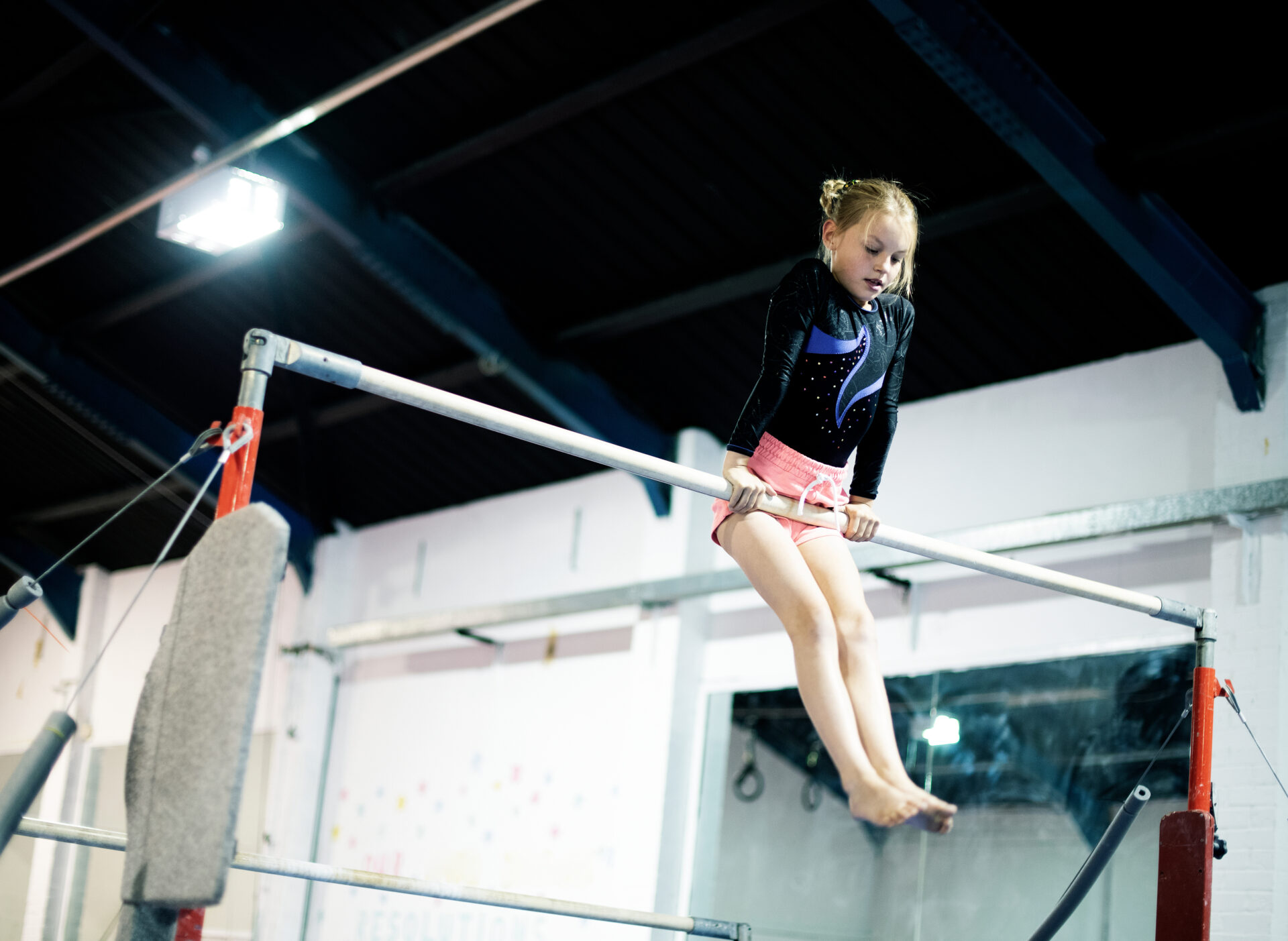
Orthopedic Treatment:
- Non-surgical Management:
- Rest and Activity Modification: Essential to allow the growth plate to heal. Young gymnasts should temporarily cease activities that involve overhead motions.
- Physical Therapy: Once pain decreases, physical therapy focuses on correcting mechanics to reduce stress on the growth plate. Strengthening exercises for the shoulder girdle and core help distribute forces more evenly.
- Monitoring: Regular follow-ups to ensure the growth plate heals properly and to avoid long-term complications.
Gymnastic Elbow Injuries – Elbow Dislocations
An elbow dislocation occurs when the bones of the elbow are forced out of alignment, typically due to a fall or direct impact. This injury can damage the surrounding ligaments, nerves, and blood vessels.
Causes:
- Common Events: Vault, pommel horse, and beam.
- Mechanisms: Falls onto an outstretched arm or direct impact during high-impact moves.

Orthopedic Treatment:
- Reduction: Immediate realignment of the dislocated elbow is critical to restoring joint function and preventing further damage.
- Immobilization: After reduction, the elbow may be immobilized in a splint or sling for several weeks to allow the ligaments to heal.
- Surgical Intervention: In cases where there is significant ligament damage or associated fractures, surgery may be required to repair the soft tissues and stabilize the joint.
Gymnastic Elbow Injuries – Elbow Growth Plates Injuries (Apophysitis)
Apophysitis refers to inflammation of the growth plate, often due to repetitive stress. In gymnasts, this condition frequently affects the growth plates in the elbow, leading to pain and potential long-term issues if untreated.
Causes:
- Common Events: Pommel horse, uneven bars, and rings.
- Mechanisms: Repetitive weight-bearing activities that place stress on the elbow growth plates.
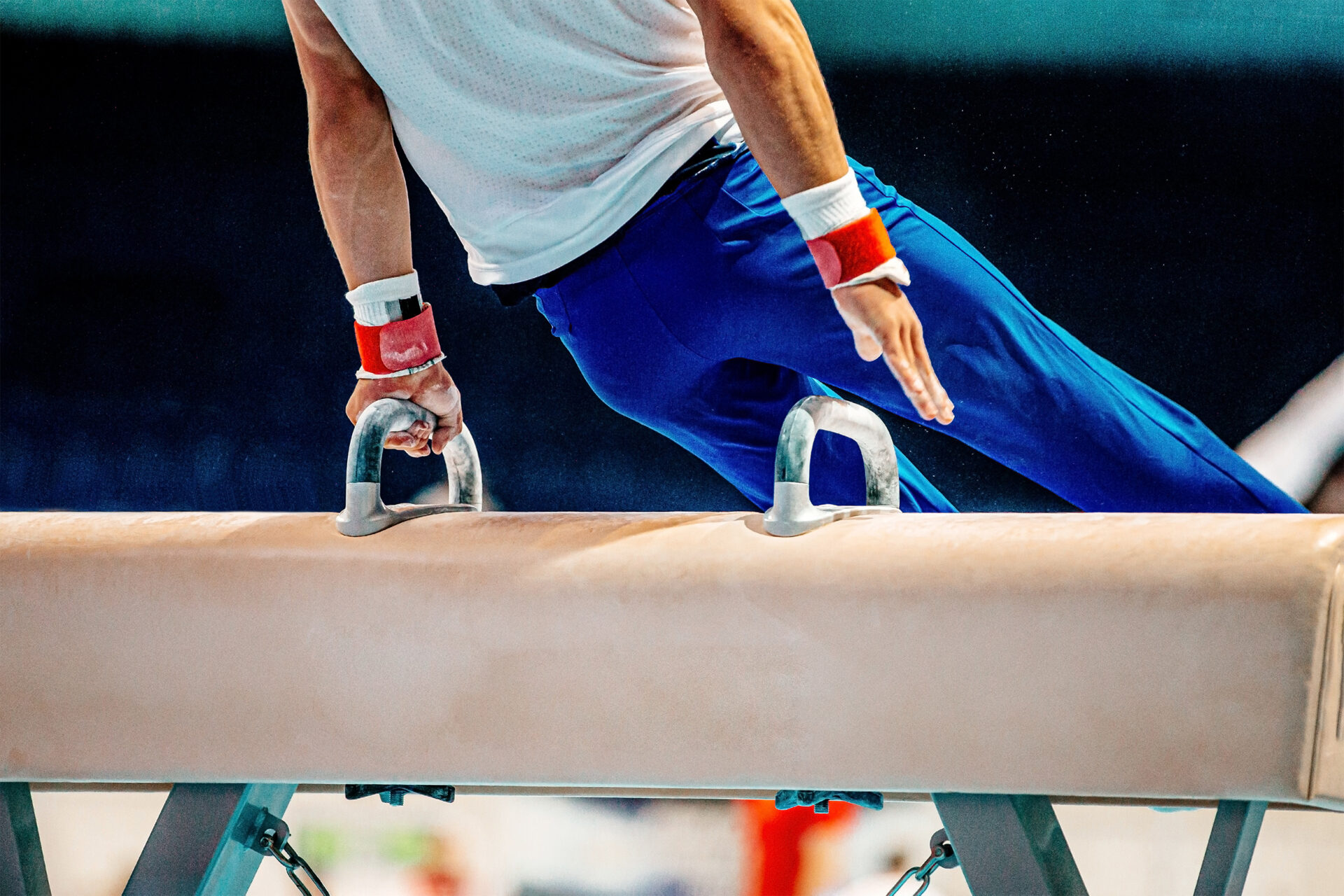
Orthopedic Treatment:
- Rest and Activity Modification: Crucial to allow the growth plates to recover. Gymnasts may need to avoid or modify activities that put stress on the elbows.
- Physical Therapy: Focus on exercises that relieve stress on the growth plates and enhance flexibility and strength in the surrounding muscles. Education on proper technique is essential to prevent recurrence.
- Monitoring: Regular assessments to track recovery and ensure that the growth plates are healing without complications.
Physical Therapy for Gymnastics Injuries
Physical therapy for gymnastic injuries focuses on a phased approach, beginning with pain management and inflammation reduction, typically using techniques like ice, manual therapy, and gentle range-of-motion exercises. As pain subsides, therapy progresses to strengthening the shoulder, elbow, and surrounding muscles. This phase includes proprioceptive training and sport-specific drills to enhance stability and prevent re-injury. Corrective exercises and technique refinement are emphasized, especially for young athletes, to minimize stress on growth plates and prevent future injuries. At AOSMI, we have a team of expert physical therapists for you to work with, so you can get back to the gymnastics sports you love.
Preventive Measures for Gymnastics Injuries
Proper warm-up and conditioning routines are essential to prepare the body for the physical demands of gymnastics. Using appropriate techniques during practice and competition can significantly reduce the risk of injury. Coaches and healthcare providers should work together to monitor the health of gymnasts and adjust training as needed to prevent overuse injuries and other common gymnastics issues.
Recover from Gymnastics Injuries with Comprehensive Orthopedic Care at AOSMI in New Jersey!
Understanding common gymnastics injuries and the importance of a team-based approach to treatment is crucial for the long-term health and success of young gymnasts. By addressing injuries early and adhering to preventive measures, gymnasts can stay healthy, competitive, and continue to enjoy the sport they love. If you or your child is experiencing shoulder and elbow pain or injury from gymnastics, request a consultation with Dr. Gallacher and our team of orthopedic experts today!
We are thrilled to announce that several esteemed physicians from Advanced Orthopedics and Sports Medicine Institute (AOSMI) have been recognized as NJ Top Docs for 2024. This prestigious honor underscores our commitment to providing exceptional orthopedic care and advanced treatment options for our patients in New Jersey.
About the Top Docs Awards
The Top Docs awards are based on a rigorous selection process. Nominees complete a comprehensive qualification questionnaire covering their education, training, years in practice, continuing education, licensing, publications, charitable work, professional appointments, and achievements. Each component is verified to ensure that nominees meet the high standards set by the Top Docs organization. Board certification is required for applicable specialties, and nominees must also undergo a thorough review of malpractice and licensing records to confirm there are no serious issues. Patient reviews are collected and compiled to provide a comprehensive assessment of each nominee’s performance.
Join us in celebrating the remarkable accomplishments of the following Top Docs nominees:

Michael J. Greller, MD, MBA, CPE, FAAOS
Dr. Michael J. Greller is a Board-certified orthopedic surgeon specializing in sports medicine and joint preservation. His comprehensive approach to patient care, combined with his administrative expertise, has established him as a leader in orthopedic surgery. Dr. Greller’s commitment to excellence is evident in both his clinical and organizational contributions to AOSMI.
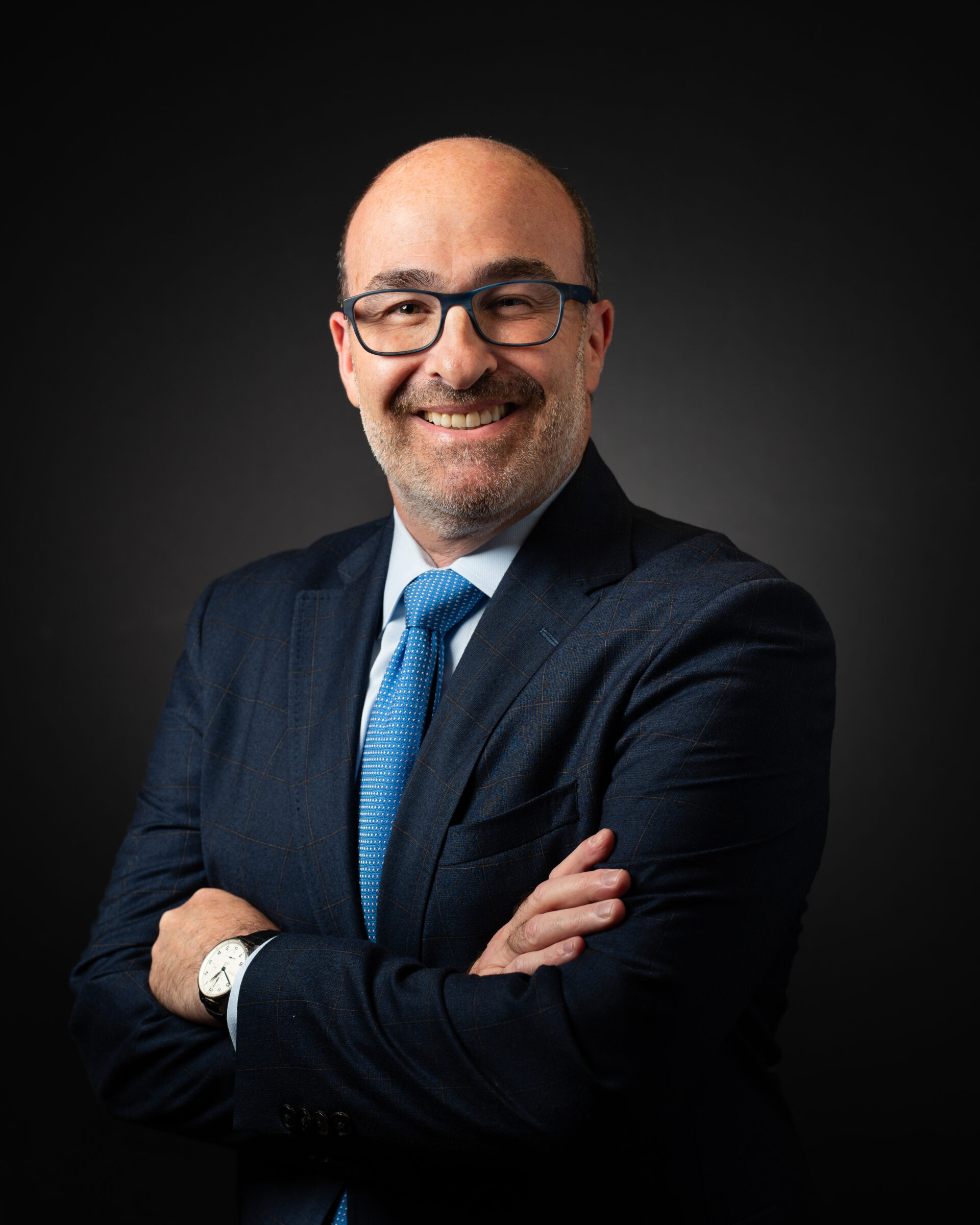
Ali Valimahomed, MD, FAAPMR
Dr. Ali Valimahomed is a dual Board-certified specialist in Pain Medicine and Physical Medicine & Rehabilitation. His expertise lies in comprehensive pain management and restoring function to patients suffering from chronic pain conditions. Dr. Valimahomed’s holistic approach and dedication to improving patients’ quality of life make him a standout in his field.
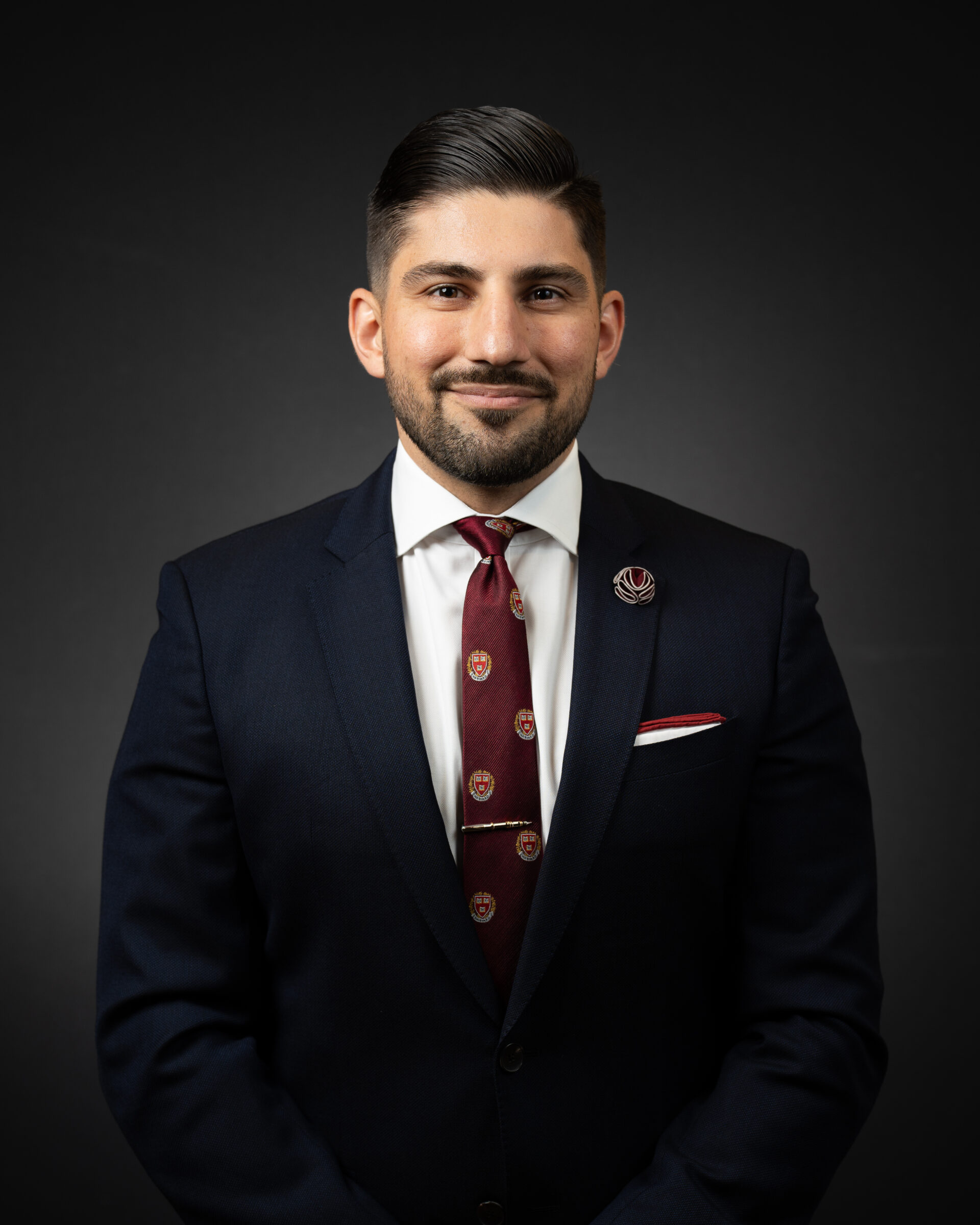
Alison Dewaters, DPM, FACFAS
Dr. Alison Dewaters is a Board-certified podiatric surgeon with a focus on reconstructive foot and ankle surgery. As a Fellow of the American College of Foot and Ankle Surgeons, Dr. Dewaters is renowned for her surgical precision and compassionate patient care, ensuring optimal outcomes for her patients.
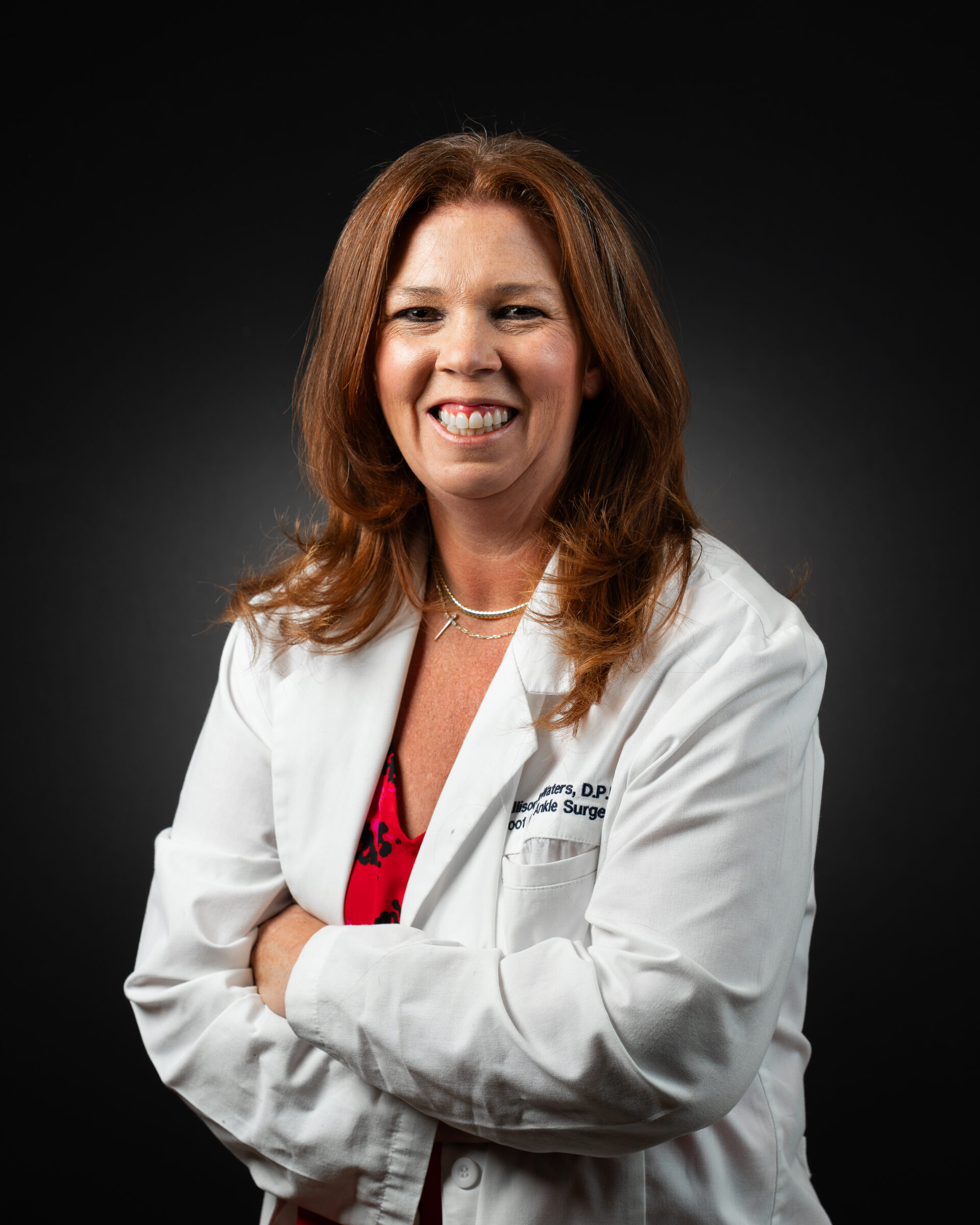
Arth Patel, MD, MPH
Dr. Arth Patel is a Board-certified Primary Care Sports Medicine physician with a background in Family Medicine. He is dedicated to the non-operative management of musculoskeletal injuries, promoting wellness and injury prevention. Dr. Patel’s patient-centered approach and emphasis on holistic care have earned him a well-deserved place among NJ’s top doctors.
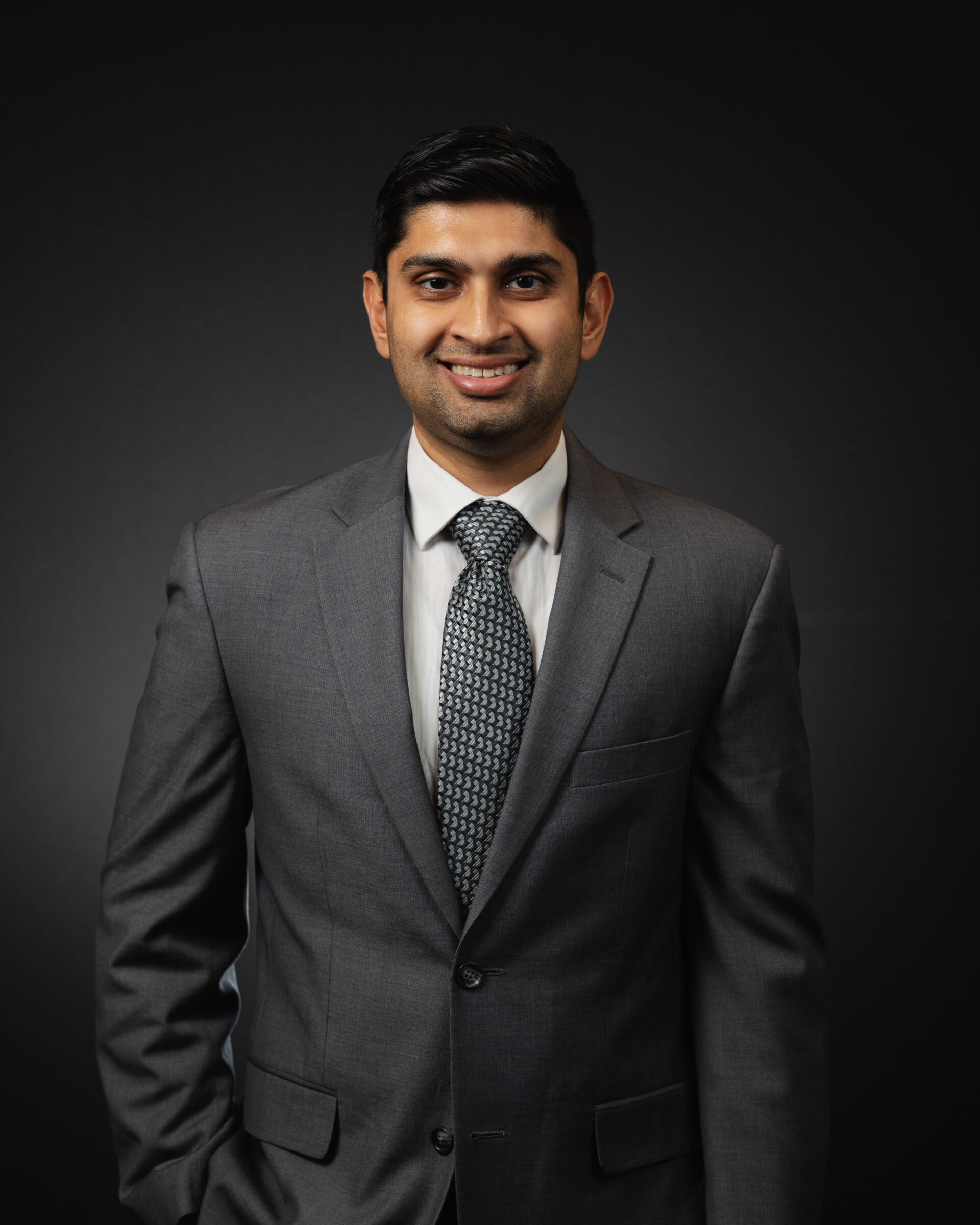
Eric Buxbaum, DO, FAAOS
Dr. Eric Buxbaum is a Board-certified orthopedic surgeon with expertise in hip and knee replacement surgery. His focus on advanced surgical techniques and patient-centric care has made him a trusted name in joint health. Dr. Buxbaum’s approach combines precision with compassion, ensuring his patients receive the best possible care.

Joseph Tauro, MD
Dr. Joseph Tauro is a nationally recognized expert in shoulder, sports and degenerative joint disorders, known for his pioneering techniques in arthroscopic surgery. As a Board-certified Orthopedic Surgeon, Dr. Tauro’s contributions to the field have set new standards in patient care and surgical excellence. His innovative approach ensures that patients receive the most advanced and effective treatments available.
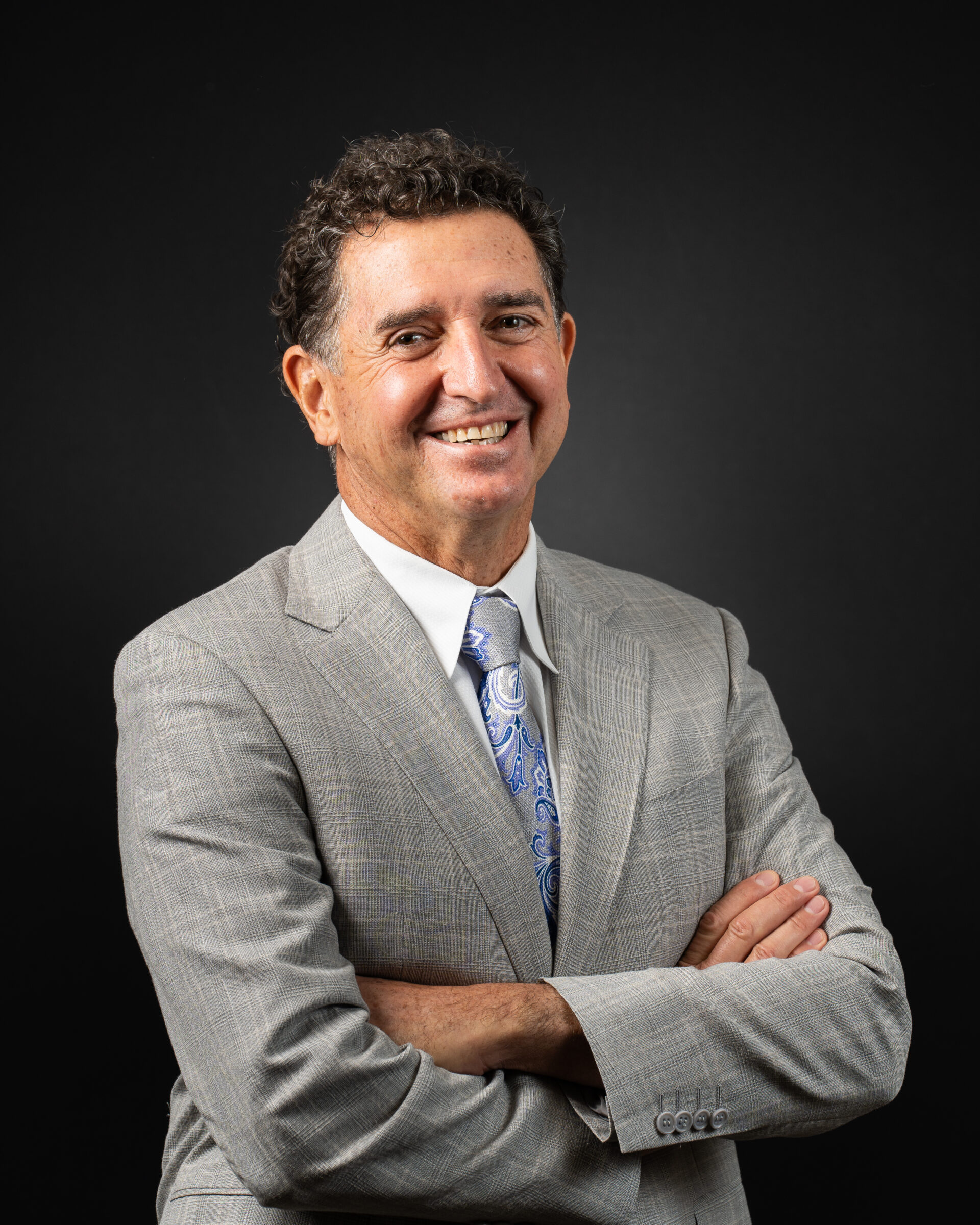
Stacey Gallacher, MD, FAAOS
Dr. Stacey Gallacher is a dual Board-certified orthopedic surgeon specializing in shoulder and elbow surgery and trauma care. Her precise surgical skills and compassionate patient care have made her a trusted specialist in her field. Dr. Gallacher’s dedication to improving patient outcomes through both surgical and non-surgical interventions is commendable.
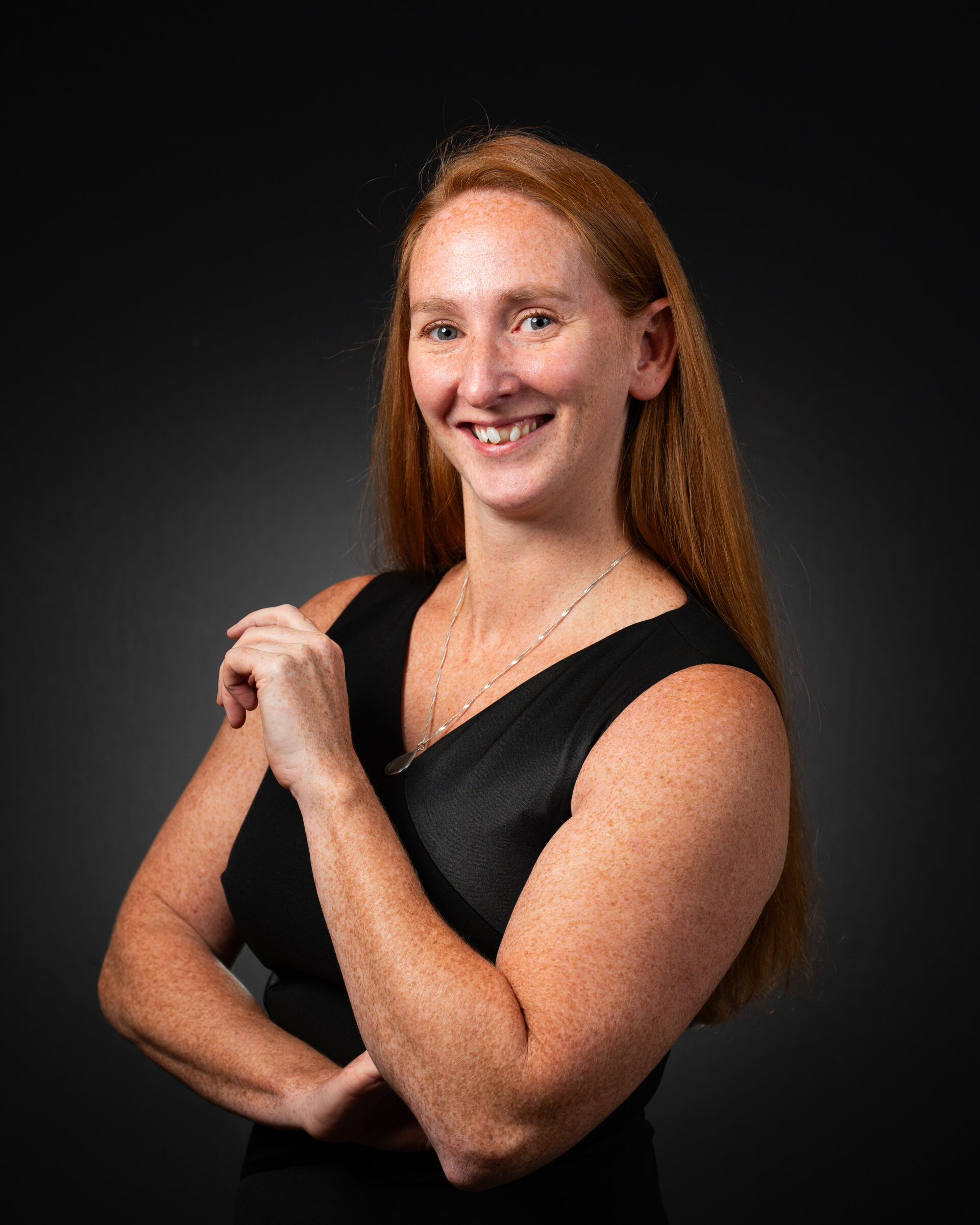
Gerardo Goldberger, DO, FAOAO
Dr. Gerardo Goldberger is a Board-Certified orthopedic surgeon and Fellow of the American Osteopathic Academy of Orthopedics. His specialization in sports medicine and arthroscopic surgery allows him to effectively treat a wide range of athletic injuries. Dr. Goldberger’s dedication to his patients and innovative treatment methods make him a top choice for orthopedic care.
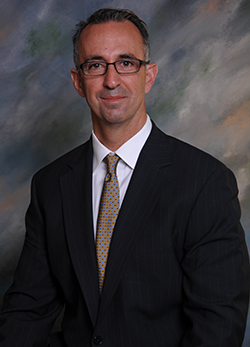
David Kirschenbaum, MD
Dr. David Kirschenbaum is an hand and upper extremity Fellowship-Trained orthopedic surgeon. His extensive experience and commitment to cutting-edge techniques provide patients with innovative solutions for their orthopedic needs. Dr. Kirschenbaum’s dedication to excellence is reflected in his high patient satisfaction and successful surgical outcomes.
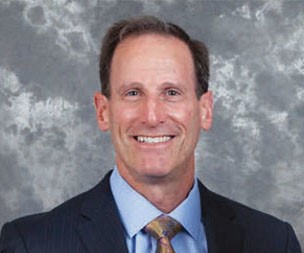
At AOSMI, we are incredibly proud of our doctors’ achievements and their unwavering commitment to providing the highest quality of orthopedic care. Being named NJ Top Docs is a testament to their expertise, compassion, and dedication to patient well-being. We extend our heartfelt congratulations to each of these outstanding physicians and look forward to their continued success in advancing orthopedic and sports medicine.
For more information or to schedule an appointment with any of our top doctors, please contact our office at (732) 335-6727 and schedule an appointment online. Together, we can achieve better health and a higher quality of life.
We are excited to announce the expansion of our spine care and sports medicine services at our AOSMI Belmar location, starting on May 2, 2024. This addition enhances the orthopedic care currently provided by Dr. Stacey Gallacher at Belmar, reflecting our commitment to providing comprehensive and specialized treatment. We’re delighted to reveal that Ali Valimahomed, MD, FAAPMR, is extending his services to Belmar after having made significant contributions at our Freehold location. Dr. Valimahomed’s addition to the Belmar facility significantly enhances our ability to deliver outstanding musculoskeletal care to the community.
Michael J. Greller, MD, MBA, CPE, FAAOS, board-certified Orthopedic Surgeon and Managing Partner at AOSMI, expressed his enthusiasm for our expansion, “On behalf of the team at AOSMI, I am proud to announce the expansion of our trusted Orthopedic and Pain Management services into Belmar. Our team is committed to providing innovative, state-of-the-art treatment options and we are excited to facilitate specialized care and rehabilitation, under-one-roof, in the heart of Belmar. In our continued commitment to excellence in healthcare, we look forward to positively impacting the lives of our patients and their families in the Belmar community.” In addition to comprehensive orthopedics, physical therapy and acupuncture services are offered at Belmar. This strategic expansion emphasizes AOSMI’s commitment to patient care excellence and outcomes. With a focus on delivering exceptional clinical results, supported by cutting-edge treatments and compassionate care, AOSMI is set to continue its mission of providing the highest level of comprehensive musculoskeletal services.
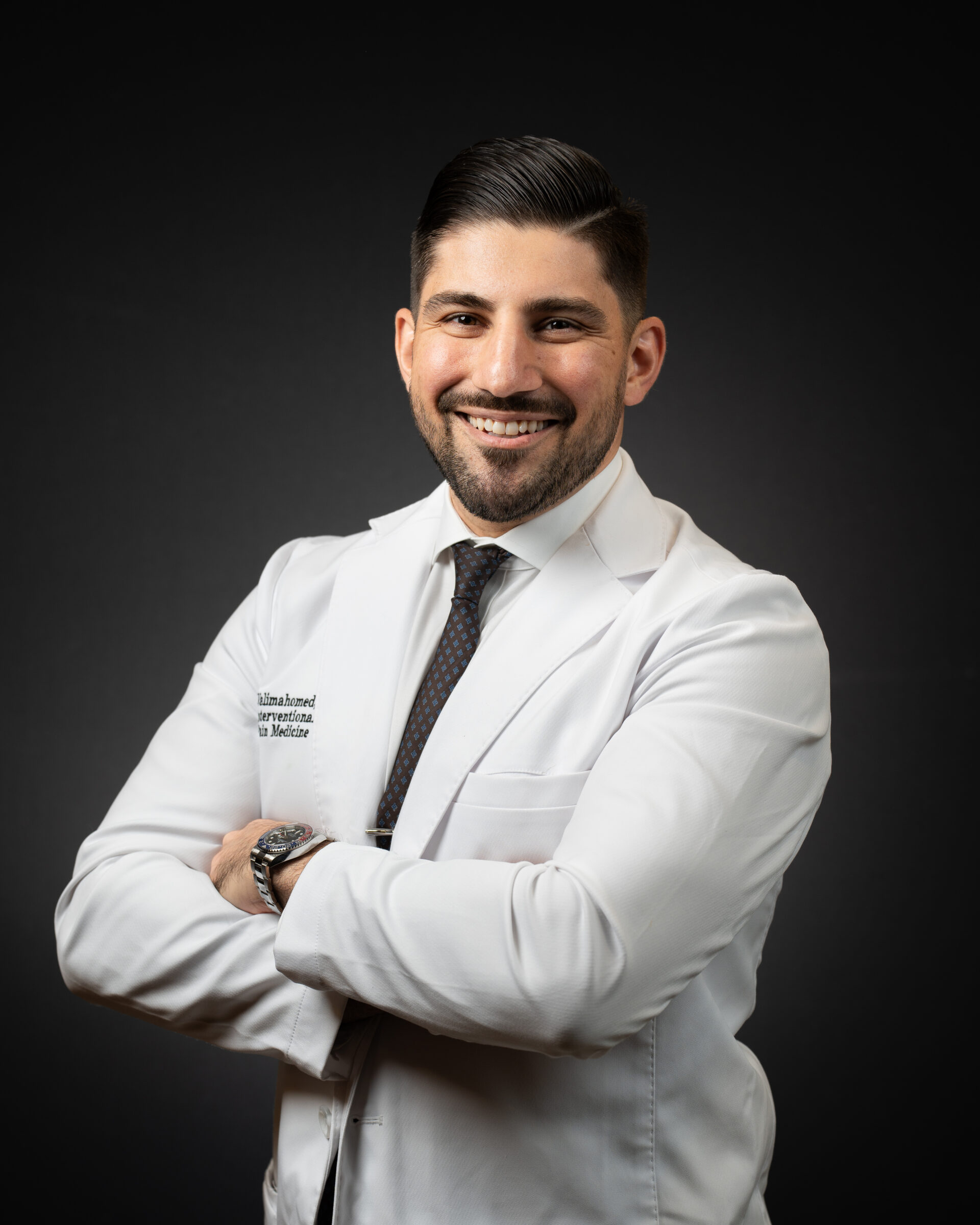
Dr. Ali Valimahomed: A Pillar of Expertise in Belmar
Dr. Valimahomed is dual board-certified in Interventional Pain Medicine and Physical Medicine & Rehabilitation. He completed an ACGME-accredited Interventional Pain Medicine Fellowship and uses the most current treatments and innovative approaches to effectively address complex pain challenges. His arrival in Belmar will enable more patients to receive high-quality pain management care closer to home.
Dr. Valimahomed specializes in spine care, musculoskeletal medicine, non-surgical sports medicine, and pain management. Whether you’re struggling with back pain, neck discomfort, or spinal issues like herniated discs or spinal stenosis, his tailored treatment plans aim for lasting relief and improved quality of life. Dr. Valimahomed addresses the source of your pain through a range of targeted interventions, including fluoroscopic-guided and ultrasound-guided spine injections, peripheral nerve blocks, and minimally invasive spine surgery. His expertise extends to conditions arising from auto accidents, work-related injuries, and sports injuries, ensuring comprehensive care. Through his treatment plans, you can strengthen your back, improve your mobility, and get back to living life to your fullest potential.
Orthopedic Excellence in Belmar: Comprehensive Musculoskeletal Care
In addition to Dr. Valimahomed’s pain management expertise, our Belmar location currently provides comprehensive musculoskeletal care, encompassing a full range of orthopedic services, physical therapy, and acupuncture.
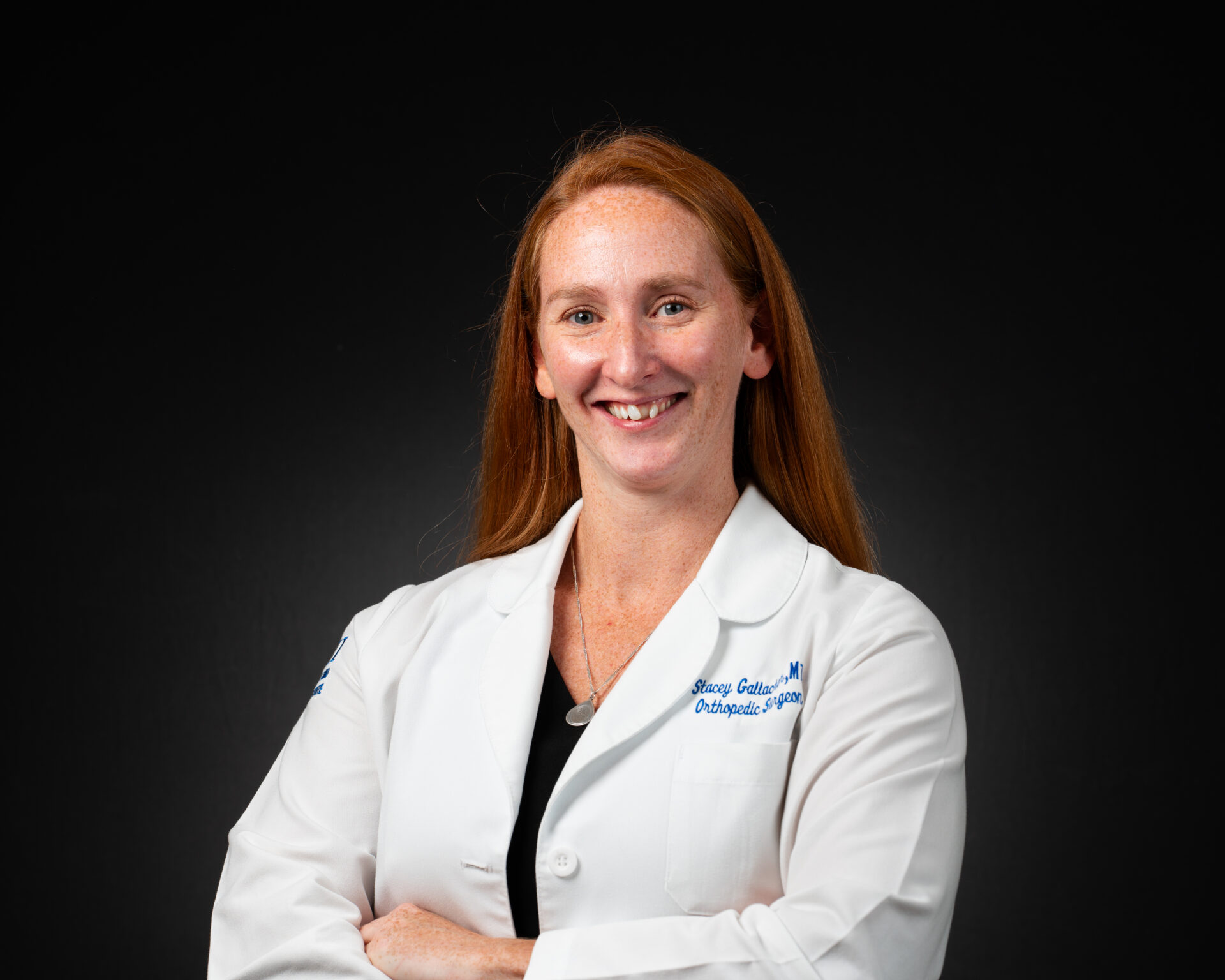
Leading the charge is Stacey Gallacher, MD, FAAOS, an accomplished orthopedic surgeon with board certification and dual fellowship training in shoulder & elbow and trauma. Dr. Gallacher’s extensive experience in musculoskeletal health ensures our patients receive the highest standard of personalized care. Dr. Gallacher addresses the full range of orthopedic injuries, with a focus on shoulder, elbow, and trauma. Our commitment to comprehensive musculoskeletal care means that patients have access to the best possible treatments for a wide variety of orthopedic conditions, all under one roof.
Whether you’re on the road to recovery following surgery, dealing with chronic pain, or aiming to improve your physical health, our dedicated team is here to guide and assist you every step of the way.
Welcome to AOSMI Belmar
Starting on May 2, 2024, located at 712 10th Avenue, Belmar, NJ 07728, AOSMI Belmar will be ready with spine care, musculoskeletal medicine, non-surgical sports medicine, and pain management. Our facility is equipped with the latest technology, and our dedicated team is committed to delivering exceptional care within your community. For more information or to request an appointment, contact us today. Dr. Valimahomed, Dr. Gallacher, and the entire AOSMI team look forward to supporting your health and wellness journey, now even more conveniently at our Belmar location.

Cubital Tunnel Syndrome, otherwise known as ulnar nerve entrapment, happens when the ulnar nerve experiences increasing pressure or compression. Have you’ve ever bumped your elbow against a hard surface and felt a sharp stinging pain, otherwise known as hitting your ‘funny bone’? That’s your ulnar nerve in action.
Second after Carpal Tunnel Syndrome, Cubital Tunnel Syndrome is the most common nerve compression that happens in the arm. The ulnar nerve can be found in a small tunnel of this in the elbow, also known as the cubital tunnel and can be compressed when your elbow is bent. This pressure on your ulnar nerve can cause a considerable amount of pain or discomfort, and may get to the point where you could lose the function of your hand (dominant or nondominant). In general, men are more likely to be affected by Cubital Tunnel Syndrome than women. People with jobs that have them doing repetitive elbow movements and prolonged elbow flexion are even more likely to experience Cubital Tunnel Syndrome.
You might have Cubital Tunnel Syndrome if you feel a numbness and/or pins and needles from the inside of your forearm to your hand. Typical symptoms of Cubital Tunnel Syndrome include; tenderness on the inside of your elbow, pain or numbness after keeping your elbow bent for a long period of time, and a difficulty in feeling the difference between sharp and dull objects when they touch the inside of your forearm. If Cubital Tunnel Syndrome goes untreated these are some symptoms you might experience; clumsy hands, having the small muscles of the hands waste away, and something known as ulnar claw hand which is when your fingers bend inwards.
If you find yourself experiencing any of these symptoms be sure to contact an orthopedic specialist. Make an appointment today with the Advanced Orthopedics and Sports Medicine Institute for a NJ pain management specialist.
A common condition in the United States, joint pain can be a serious hindrance to athletic activity as well as everyday life.
An estimated two million American experience joint pain associated with cartilage injuries each year. Cartilage injuries can be debilitating and only the most modern methods of treatment can restore cartilage, minimize pain and relieve discomfort for patients of all ages.
So what is cartilage?
Cartilage is, essentially, connective tissue found in all animals, including humans. It is more flexible and softer than bone but stiffer and more rigid than muscle. As cartilage does not contain blood vessels or nerves, you cannot “feel” damage in your cartilage, though there are other signs.
There are three types of cartilage found in the human body.
Elastic cartilage is found in your ears and nose. This supports and adds shape to these structures. Fibrocartilage is tough and dense. This type is found in the joint connecting the upper pubic bones where it needs to be sturdy enough to support a lot of weight but flexible enough for childbirth. Fibrocartilage, such as the meniscus, can also be found in joints where the more flexible tissue has been destroyed. The meniscus transfers stress and protects the final type of cartilage, hyaline cartilage, from being damaged. Hyaline cartilage is the cartilage that allows healthy joints to function comfortably. Found in your joints, this type of cartilage can be degraded by arthritis, trauma and other conditions causing medical treatment to be needed.
The Cartilage Restoration Center of New Jersey, staffed by the board-certified and fellowship-trained orthopedic surgeons of AOSMI, utilizes the latest techniques to restore cartilage.
We are completely devoted to the treatment of cartilage injuries with the goal of eliminating pain, restoring function and facilitating your return to full activity.
So you suffer from joint pain and think you may have damaged your cartilage, what are your options? Joint replacement surgery and medication used to be your only option to deal with joint pain. Now with our cutting-edge technology, the board-certified physicians at AOSMI are able to offer you many conservative options, including:
- Anti-inflammatory medications (NSAIDs)
- Steroid injections
- Hyaluronic Acid injections
- Orthobiologics
- Physical Therapy
- Bracing
If conservative treatment options do not work or if the cartilage damage is too severe, there are several surgical options that focus on repairing or re-growing your cartilage, helping reduce the need for joint replacement surgery. Procedures include:
- Microfracture: An arthroscopic procedure that stimulates cartilage regeneration
- Osteochondral Autograft Transplantation – Utilizing bone and cartilage plugs taken from a low load area of the knee and transferred to the damaged area
- Osteochondral Allograft Transplant – Used when donor bone and cartilage plugs are applied in the damaged area
- DeNovo NT – Used when juvenile donor cartilage is used to repair the damaged area
- Autologous Chondrocyte Implantation – Your cartilage cells are harvested via arthroscopic surgery, grown in a laboratory and then transplanted into the damaged area
These surgical options would be performed by our board-certified, fellowship-trained orthopedic surgeons at a hospital or outpatient surgery centers depending upon the procedure.
If you suffer from joint pain or feel you may have damaged your cartilage, call us today to schedule your cartilage consultation – 732-720-2555!
With more than 50 million Americans (one in five adults) suffering from the chronic pain of Arthritis, May has been named National Arthritis Awareness Month. Why all the recognition? Arthritis is the number one cause of disability in our country and affects over 300,000 families. While commonly recognized, little is still understood about the illness and most do not understand the catastrophic effects Arthritis has on those who suffer and those who love them. NJ physical therapy centers report that a large percentage of their patient load is comprised of those looking to ease the physical pain of the illness while maintaining mobility. As we enter into May, let’s stop and take a look at a few facts about Arthritis.
- By 2030, up to 67 million adults are expected to be living with Arthritis.
- Arthritis is not just an illness that affects those in old age. Nearly 300,000 infants, kids, and teens suffer with a form of the disability.
- An average of 172 million workdays are missed every year by those suffering from Arthritis, and these workers are less likely to maintain regular employment than those without the disability.
- On average, the country sees one million hospitalizations a year due to Arthritis-related injuries and conditions.
- $156 billion dollars worth of lost wages are seen every year as a result of the illness.
Now that you understand more about the condition, how can you help?
There are a number of reputable organizations dedicated to helping those with Arthritic conditions. To get involved with the cause, contact the Arthritis Foundation to learn about making donations, volunteering to help with their events and signing up for their e-newsletter. If you are suffering from the pain of Arthritis yourself, call AOSMI today to speak with an orthopedic specialist about how physical therapy and pain management services can help you.
Whether you’re recovering from a sports injury or are simply experiencing the annoyances of physical pain from the daily grind of day to day living, there are a few simple movements you can try to help relieve your pain. As contrary as it seems, stretching is your saving grace when it comes to dealing with physical pain. Here we offer a few simple movements to get your muscles and joints moving and relieve common pains. As always, if the pain persists or worsens, call an orthopedic specialist to have it looked at. Stretching will not treat physical injuries or solve underlying conditions.
Simple Movements To Relieve Body Pain:
- Hamstring Floor Stretch: Designed to relieve lower back and leg pain, this hamstring stretch move will loosen the leg muscles and provide relief from cramping, spasms, and generalized aches from overuse. To execute, simple lay on your back with both knees bent. With both hands placed behind the knee, lift one leg at a time for 30 seconds. Lift each leg five or six times and then rest.
- Knee To Chest Stretch: This easy stretch is designed to ease pressure on the glutes and help reduce hip pain. To execute, lay on your back with both knees bent. Place your hands around one knee and pull that leg up to your chin (keeping it bent). Return to the starting position and then move to the other leg. Do four or five lifts on each side for maximum relief.
- Spinal Stretch: Your spine controls nearly all your movements. Stretching the muscles, joints, and ligaments that comprise this lifeline will provide all-over relief from aches and pains. An easy spine stretch involves lying on your back with legs outstretched and your arms spread out. Take your left arm and reach over your body to grab your right knee. Pull that leg over the left side of your body (with the knee bent) and hold for twenty seconds before returning to the starting position. Do the same for the other side. Do the motion between five and six times on each side for maximum effect.
These simple movements should keep you pain-free all summer. Again, if pain persists, is acute, or worsens with stretching, call AOSMI to request an appointment with an orthopedic specialist and have your injury diagnosed and treated.
Advanced Orthopedics and Sports Medicine Institute is a medical practice located in Freehold and Monroe, NJ, our medical professionals are experts in orthopedic surgery, joint replacement, sports medicine, integrative wellness, spine care, physical therapy, and more.
Musculoskeletal health refers to the overall health of the muscles and bones that comprise your body’s systems. Understanding the key elements that go into keeping your musculoskeletal system in working order is key to preventing sports injury, body pain, and illness. Our team of New Jersey orthopedic surgeons has comprised a short list of what you need to know about your body’s musculoskeletal system.
What You Need To Know About Musculoskeletal Health:
- Nixing The Soda Can Save Your Body: Soda, especially regular and diet colas, have been shown to lead to osteoporosis. The reason for this lies in the fact that these popular drinks prevent calcium absorption and lead to lower bone density. Be kind to your bones and drink water rather than soda.
- Stand Up Straight: Your mom was right; your posture is crucial to overall health. Poor posture can lead to strains in the wrists, shoulders, elbows, and back and cause persistent pain and muscle damage.
- Get Moving: Whether you’re interested in weight loss or not, getting up and moving around on a regular basis is crucial to musculoskeletal health. Living a sedentary life has been shown to cause painful and dangerous loss of muscle and bone strength and puts you at risk for a host of injuries.
- Slim Down For Your Health: Maintaining a healthy weight is about more than fitting into the latest summer fashion trends. Being overweight has been shown to affect everything from cardiovascular health to the performance of your bones and muscles. The main reason is that all of this extra weight puts undue pressure on your bones and muscles and leads to deterioration and possible injury. In keeping with our previous tip, get up and get moving to keep your system from having to overwork itself to support the weight of your movement.
- Sleep Well: All too often our society places prestige on working around the clock and missing out on crucial sleep time. This does more than lead to overtired, cranky Americans. It is putting all of our systems at risk for disease, injury, and increased pain. To highlight this point, studies have shown that one night of missed sleep can trigger cellular action that can lead to tissue and muscle deterioration. Imagine what regular lack of sleep is doing to your body!
Now that you know the basics of musculoskeletal health, incorporate these tips into your daily life for improved overall health and a reduction of aches and pains. If the pain persists or your suffer an injury, call AOSMI to request an appointment with a sports injury specialist today.
Advanced Orthopedics and Sports Medicine Institute is a medical practice located in Freehold and Monroe, NJ, our medical professionals are experts in orthopedic surgery, joint replacement, sports medicine, integrative wellness, spine care, physical therapy, and more.
 After breaking her arm, Rayanne B. found comfort at Advanced Orthopedics. With the help of Dr. Alan Nasar and his medical assistant Brielle, Rayanne received a beautiful, glittery cast to protect her arm as it heals. Having a pretty cast to wear was able to bring a smile back to her face.
After breaking her arm, Rayanne B. found comfort at Advanced Orthopedics. With the help of Dr. Alan Nasar and his medical assistant Brielle, Rayanne received a beautiful, glittery cast to protect her arm as it heals. Having a pretty cast to wear was able to bring a smile back to her face.



